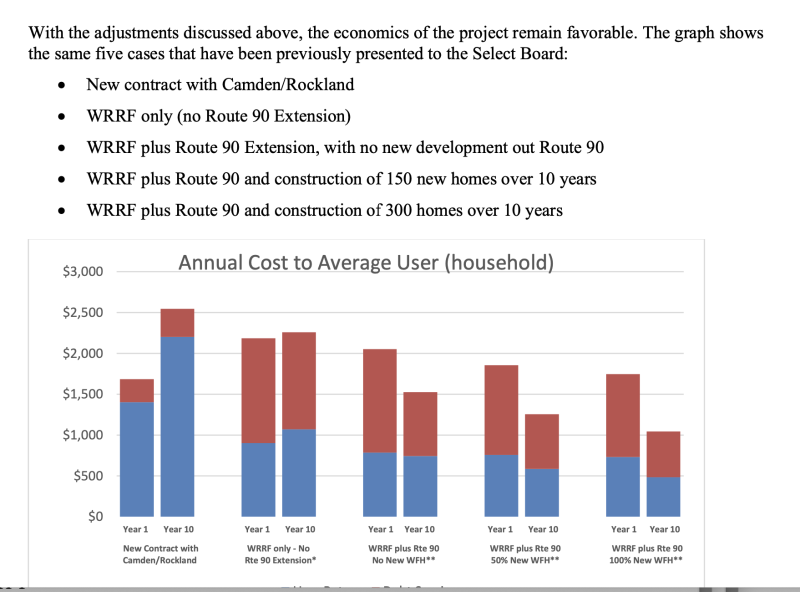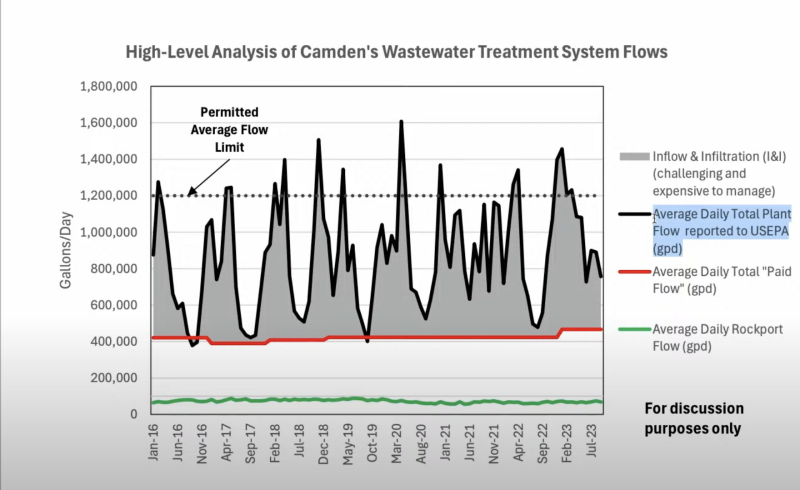Rockport considers two-track approach to resolve sewer issues: going it alone, with attempt to maintain Camden connection
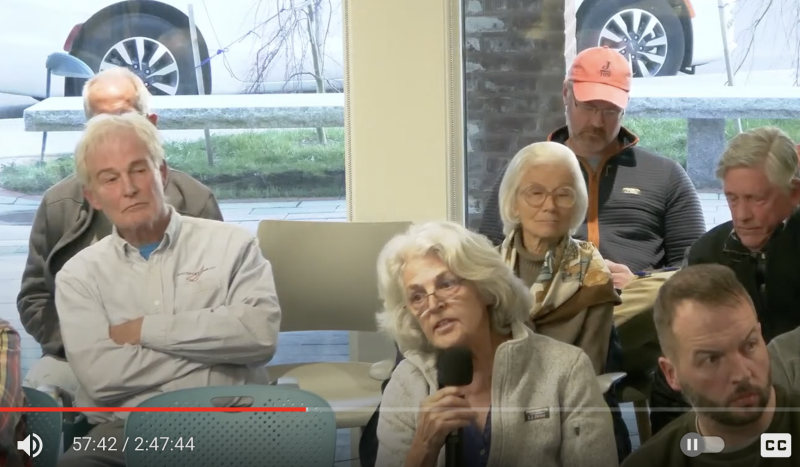
ROCKPORT — Nothing has to be decided in the near term, and there is room to adjust course; but either way, Rockport has to make progress resolving its sewer issues. With that in mind, the Rockport voter will consider two ballot questions June 11 at the polls, and they don’t have to mutually exclusive.
Over the past two months, a debate has strengthened in Rockport: Should the town pursue building a $33 million-plus ($52 million with costs and interest) sewage treatment plant at Pen Bay Medical Center, or try to collaborate with Camden, where Rockport currently pumps a good portion of its wastewater from Rockport Village and the length of pipeline along Route 90 to Camden Hills Regional High School.
Rockport’s wastewater is treated along with Camden’s wastewater at the facility behind Camden-Rockport Middle School in Camden, before the effluent is then discharged into Camden Harbor. Rockport has been pumping its wastewater to Camden since the mid-1980s, under a 30-year inter-local agreement.
But an upheaval in the Camden-Rockport inter-local sewer agreement, just as it was due for renewal, and rising sewer rates in Rockport erupted four years ago resulted in a disagreement that devolved into a lawsuit between the sister towns.
That is when the public was left in the dark as discussions and negotiations took place behind closed doors in executive session, or in court mediation sessions taking place over Zoom. Occasional announcements were made, while select board chairs from both towns, along with town managers, met for coffee or lunch, trying to find common ground.
But, both towns were not always finding common ground, and sharp accusations were occasionally fired across the bow. There was a growing sentiment that Rockport consider going it alone with its own sewage treatment plant, and when one of the proposed sites for that project marked a park at the head of Rockport Harbor, citizens reared their heads. Subsequently, a citizens’ group formed, calling itself the Rockport Wastewater Working Group.
Earlier this month, the group circulated a petition in Rockport calling for constructive talks to resume between the towns. The petition read: “Do you favor requiring the Rockport Select Board to appoint an advisory committee to study the costs and benefits of a collaborative approach for improving wastewater treatment systems in the towns of Rockport and Camden, including a municipal utility district, and to have such committee report findings to the Board prior to the 2025 Rockport Town Meeting and prior to funding the construction of a new wastewater treatment plant?”
The group is chaired by Taylor Allen, of Rockport, and in a news release he said he and others, “have watched with growing dismay as lawsuits, failed mediation and persistent miscommunications between the towns’ respective select boards has led to the current impasse.”
Approximately 300 signatures were gathered in favor of placing the question before voters on the June 11 Town Meeting warrant.
On April 8, the Rockport Select Board agreed to place the question on the warrant. At the same time, however, the four-member board also endorsed placing a question before voters asking if they approve construction of, “a new wastewater recovery facility on property currently owned by Pen Bay Medical Center located at 6 Glen Cove Drive, including engineering and design costs, transaction costs and other expenses reasonably related thereto (the “Project”)....”
Proponents of the project maintain that the new facility would bear out in lowered costs to the users over the next decade, especially if the sewer pipe would be extended along Route 90 to West Rockport, with hopes that 150 to 300 new workforce housing units would be constructed somewhere along that path.
The Pen Bay Medical Center campus site was considered attractive for its existing outflow pipe into Penobscot Bay. Additionally, PBMC already has a small treatment plant, and the WRRF Task Force has had preliminary discussions with PBMC about advancing a recirculation system and to use treated water for its boiler system — a step toward increased sustainability.
Voters will also be asked in that same warrant article question to appropriate $33,667,000. That project would include interest of approximately $18 million, and the town would borrow to cover the project costs with a 30-year bond, as well as seek state and federal wastewater funding grants.
Currently, Rockport has $6.3 million in outstanding bond payments.
April 8 Rockport Select Board meeting
Monday evening, April 8, members of the Rockport Wastewater Working Group urged the Select Board to delay placing its new sewer treatment plant proposal before voters. That was after Rockport resident Bill Bow, who has been the lead voice of a task force created a year ago by the Select Board to investigate how the town might build its own treatment plant, outlined most recent financial projections, along with Rockport Finance Director Megan Brackett.
Bow and the task force has been credited with analyzing and assessing possible locations, systems and costs associated with establishing a Water Resource and Recovery Facility (WRRF), as well as projecting finances and cost to the sewer system user.
Brackett said April 8 that combining a Route 90 sewer extension with the WRRF construction would offset costs. The town has projected between 150 and 300 new housing units along Route 90 could be constructed, given developer interest.
“A series of housing developments around town, and further commercial developments along Route 90 have been placed on hold until Rockport has a long-term solution for the disposal of its wastewater,” Town Manager Jon Duke had written in the Select Board memo preceding the meeting.
“It is presumed that within 10 years of extension there is a 90 percent take rate, which means that once a line crosses in front of your property approximately 90 percent of those property owners connect to the system within the first 10 years,” she said.
Her office had produced several models, some based on projections of a new housing development near the Route 17 intersection.
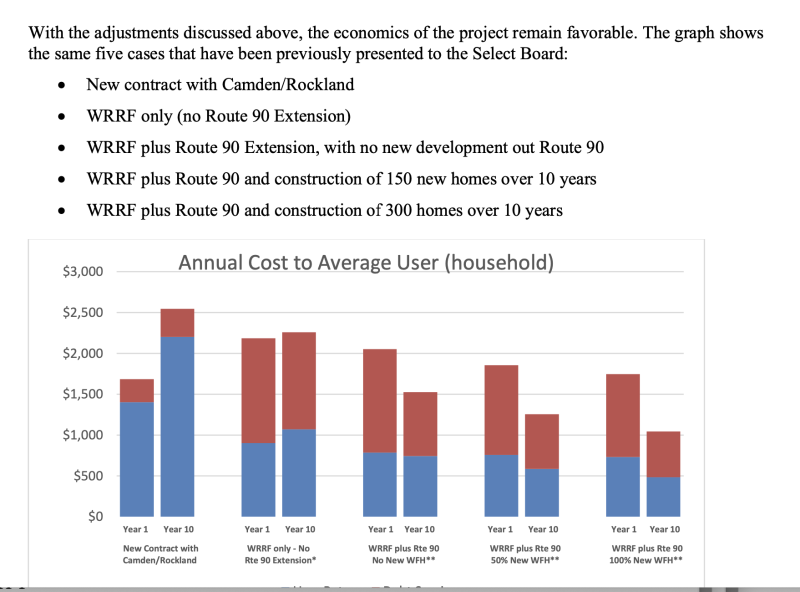
Without extending the sewer along Route 90 but building a new facility at Pen Bay Medical Center (the favored site of four possible locations, on a slice of property that the town would purchase), a user would see a $670 annual increase in sewer bills, but that would decrease over a 10-year period, she said. By year 10, the increase would be $202.
A new WRRF along with the Route 90 extension, but no housing development and just 70 percent take rate, the annual user cost would be less, as would the Route 90 sewer extension with 50 percent more housing development. The latter would result in a $340 increase to the rate payer, but year 10, the user would see a $720 savings per year.
And, she said, with a new sewer line along Route 90 to West Rockport, with 100 percent of the anticipated housing built, the sewer user would see an increase in rates of $230 by year one, and a savings of $913 by year 10.
Sam Clark, a member of the WRRF Task Force, was skeptical of the numbers, saying, “the methodology is not quite right.”
He encouraged the Select Board retain, “somebody with knowledge to look at this,” and said, “why not take more time to make sure the numbers match.”
Bill Bow said, however, that he and other members of the WRRF Task Force — Doug Cole and Bob Kollmar — “are recommending the warrant article gets placed and approved, so the Rockport voters have a chance to approve it. We also believe we need another chance to talk to Camden in further discussions.”
Bow said they operated under five guiding principles in exploring a WRRF development, with the two most important being “fair price and increased capacity.”
“I want to make a point that it is not appropriate that Rockport users agree to remain on Camden’s system regardless of cost,” he said. “If we are going to try and grow the community, we need that allocated capacity.”
Camden’s system does not have the capacity to handle development along Route 90.
“The Rockport plan is economically viable, and gives Rockport the opportunity to cost effectively treat wastewater and allow for development,” he said.
Bow also advocated for more conversations with Camden.
“It should not be that hard,” he said. “You just have to have two parties with something to gain.”
Moving too fast
Taylor Allen said it was discouraging to hear Camden portrayed by Rockport leaders.
“With that kind of an attitude I’d be surprised if Camden would even want to talk with us,” he said. “We are proposing the stand-alone system does not go on June ballot and a citizens group from both Camden and Rockport come together to look into the details of what it would look like for the two towns to cooperate. It is a fairly complicated issue.”
Philip Conkling, a longtime resident, first of Rockport and now of Camden, asked Bow, “have you talked to any of their wastewater treatment people or community leaders to reality test assumptions you have made.”
“I shot Audra an email about a week ago,” said Bow, before describing the process of the task force, which was exploring the feasibility of a new Rockport facility.
“Just to interrupt,” said Conkling. “To understand, doesn’t someone need to talk to them?”
“We need to talk with them,” said Bow. “I reached out initially and was not met with a response.”
Conkling responded: “You are advocating for something based on a lot of assumptions.”
Rockport Select Board Chair Denise Munger then broke into the exchange, “Stop, Philip. Please.”
She said that Rockport has been working hard on the issue for five years.
“We are all trying to do the best for Rockport,” she said.
Rockport resident Martha White questioned Bow’s reasoning, as evidenced in a graphic he produced that illustrated Camden’s sewer system, its periodic overloads, and system infiltration from other sources than wastewater, referred to as INI.
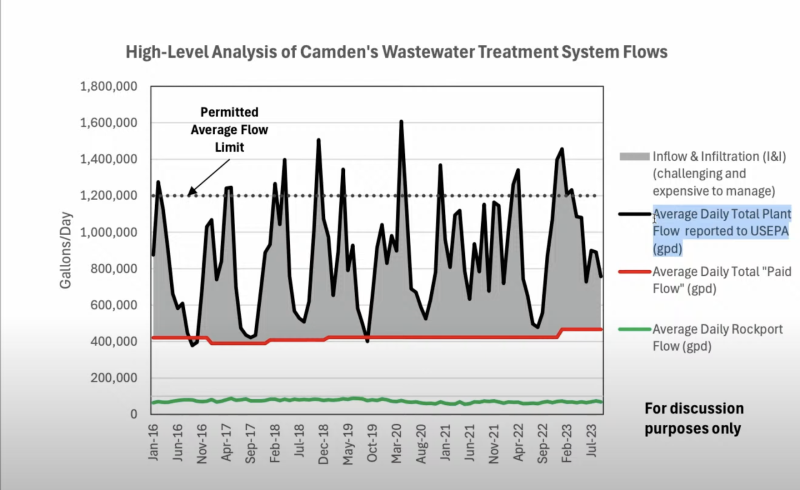
“Isn’t it also true that if you look at that same chart, and come to the point of view that if Rockport were working with Camden helping to solve the problem of their INI, that there would be more capacity for Rockport,” she asked. “And that the green line that you show at the bottom of the chart seems to clearly show that Rockport’s input into their system is not their problem. But if we stayed in the system to help solve their problem, the system that we have been a part of for 30 years —wouldn’t that help create more capacity and solve our problem as well as theirs, and plus be more neighborly in the process.”
“Yes,” said Bow.
“It would behoove us to find out before spending $40,000,” said White.
Stuart Smith, of Camden, and who owns property and a business in Rockport, admonished Rockport leadership for its behavior over the past several years.
“I don’t want to call a spade a spade, but the group that started this issue was not the Camden Select Board, but was a past Rockport Select Board,” he said. “They are the ones that refused to play, They’re the ones who put the thing into court…. So if I was sitting on the Camden Select Board, I wouldn’t be sending Valentines to the Rockport Select Board.”
He said Rockport’s contractor for sewer operations, Woodard and Curran: “gave you terrible advice about how much you should be paying.”
Smith said that Camden is willing to work with Rockport, endorsing a committee be formed representing both towns to constitute a sewer system.
The WRRF, “is $40 million of wasted money,” he said.
“$33 million,” said Munger.
“By the time you get to this thing, it will be a $50 million project,” said Smith.
Historical context
Munger then presented background to the Camden-Rockport dispute, identifying the cause. She spoke to a room full of citizens who had gathered for a regularly scheduled Select Board meeting at the Rockport Public Library,
In 2020, Rockport sewer users were paying the same rate as a Camden sewer user and that meant Rockport sewer users were essentially paying double, she said. “They were paying for the Rockport collection system and on top of that, they are paying for the Camden collection system, as well as the Camden sewage treatment cost. So Rockport has some of the highest rates in the state, double what Camden users are paying.”
According to the WRRF Task Force: “For the volume of wastewater that is metered by Camden at the Town line, Rockport pays the same “user rate” that is charged to Camden residents. However, in Camden, the ‘user rate’ also pays for operating and maintenance of the distribution system. In Rockport, it does not – we must pay for that separately. That almost doubles our cost.”
Munger said, “that was the nut of the problem when we began negotiating over a new local agreement.”
Woodward and Curran, meanwhile, was assessing other shared municipal sewer systems whose fees were based on proportion of use.
That was in January 2020, Munger said. Two months later, the pandemic ensued, and, “town government was frozen.”
In the negotiation process, Woodward and Curran sent proposed figures to Camden, “and Camden came back and said we are not sure we are going that way; they shifted, ‘we think Rockport should pay the full rate that every Camden user pays,’” said Munger.
Woodard and Curran revised proposed numbers and sent them to Camden. Then, there was a pause in communication.
Rockport then heard, “We want the full user rates,” said Munger, and 2021 arrived with, “a full-on revolt from sewer users in Rockport.”
She said there was a good faith attempt to work with Camden to find the problem: “Which was this notion that Rockport users are paying for the entire Camden sewer system, not just the portion that we benefit or use. And we could not get the Camden Select Board or town manager to negotiate with us. It was the pandemic. Town revenues had been cut off, and so many other things going.”
In November 2022, there were no conversations with Camden, “despite requests,” said Munger.
Camden filed a lawsuit then against Rockport for nonpayment of fees.
“We wanted to get their attention,” said Munger. “We were not intending to underpay them. We felt we needed to take a stand for our sewer users. It never occurred to us that they would let that go for six months and not even talk to us. We assumed that we were neighbors and were going to be able to work together. We could not get them to work with us, to return our calls, to even respond to engineering analyses.”
In the mix was a budgeting error, which should have been acknowledged.
“We immediately paid up, corrected the math error, and expressed a willingness to work together,” said Munger. “We went forward, ending up in mediation via Zoom.”
There, the two towns sat in separate digital rooms, comprising respective board chairs, town managers and attorneys.
“The mediator comes to us, ‘OK, let’s talk about this. Is this a divorce or a long-term agreement?’ We said, we want this to be a longterm agreement. We want to work with Camden,” said Munger. “He said OK. He goes to the other Zoom room with the Camden folks. And it is quite a while, actually. Twenty minutes later he comes back to us and says, ‘it’s a divorce. So let’s talk about the divorce terms.’ So that’s how we spent the rest of that meeting.”
A month later, the two towns settled on agreeable divorce terms, “but a key point in Camden was that we get off their system in six years,” said Munger. The date set was 2026.
On Aug. 2, 2023, there was another meeting, which was productive, she said. A plan emerged that Rockport would have ownership in the Camden system; therefore, be in the position to bond funding for helping to repair Camden’s system. All was going well, she said. “We were talking about having a barbecue together, everything was so great.”
But at a Sept. 5 Camden Select Board meeting, the terms changed. Prior to the meeting, Camden had agreed to a 15 percent reduction for wastewater rates, but at the meeting, the board did away with that reduction.
“Within a month of this meeting, they are already in public in a meeting taking away something that had been bargained and agreed to,” said Munger. The Camden Select Board had indicated it wanted to focus on its system. “We heard some of their Select Board members, ‘we have to figure out our system before we talk to Rockport.’”
She told Rockport citizens: “I’ve had coffee and lunches with various SB members, trying to work together. Why can’t we solve this wastewater issue. Why can’t we work together?”
Munger concluded with a nod toward the graphic that Bow had presented at the April 8 meeting.
“This graph illustrates that there are issues,” she said. “They have other issues. I am willing to talk with Camden,” but, she rebuked the accusation that the impasse was the fault of Rockport.
Smith countered by again encouraging the creation of a two-town citizen committee.
He likened putting a bond on the ballot, “is like throwing fuel onto the fire.”
What Rockport thinks
Munger then opened the floor to comments pro and con for a bond. She said there were six federal grant programs the town could pursue for help in funding the WRRF project.
“This will give us leverage with Camden, and if that town is serious, it will come to the table,” she said.
Sam Clark again looked at the economics of building a WRRF specifically for Rockport.
“All of this means we need more economic growth, how does this not chill economic growth,” he said. “We really need to drive economic growth but the moment you put it in it impinges on those already there. If you don’t have extra users, those people are stuck with that number. Right now, it is under $300 a year. This changes significantly.”
Munger advocated that a sewer extension would trigger economic development.
“It is the only to grow the pie in Rockport to develop the tax base,” she said.
Munger asked the group that had circulated the petition, “Is there a companion petition in Camden.”
“I’m not aware,” said Conklin.
“Once again, Rockport has to talk to Camden but Camden does not have to talk to Rockport,” said Munger.
Taylor Allen advocated for a unified system, such as what was created 25 years ago with the Five Town CSD (Camden Hills Regional High School), by having the five sending towns owning the school district together.
“The idea that Rockport voters are going to understand what they are actually going to understand what is on the ballot, in two months, is not going to pass,” he said. “I may be wrong but I’d be floored if it would pass.”
Others questioned the emphasis on workforce housing development, “however the suitability of art proposed along route 90 being served by the system and capacity of drinking water reservoir and school systems ought to be more thoroughly assessed,” said Sam Temple, Rockport resident. “300 houses is significant. More developed places have higher taxes because they need more services.”
Rockport resident Sally Cook cited a need for slowing the process and obtaining more information. “I keep thinking, what is the rush,” she asked.
“We are willing to work with Camden,” said Munger. “I believe we can put WRRF on the ballot and still have time to continue discussions with Camden and if Camden’s gotten religion now and really wants to talk with us, we are happy to do that.”
Martha White said: “That’s like saying to your husband, I’m hiring the lawyer and going down this road, but am still working with you. A little disingenuous and doesn’t seem to serve the purpose and act toward reconciliation.”
She said Rockport got bad advice during mediation.
“Divorce was not part of the lawsuit,” she said. “You simply did not have to answer the question.”
“We are the mercy of Camden,” said Rockport resident Betsy Elwin. “We’re going to pay whatever Camden tells us to pay because we have no choice.”
She recommended moving forward with the WRRF question on the ballot, which, “will strengthen our position,” she said. “Camden will see the Rockport Select Board is trying to move us toward a solution. Time is not on our side and we need to move forward to a solution. We can talk with Camden but cannot wait longer because it is only going to cost us more in the future.”
Rockport resident Bill McCLellan likewise advocated for placing WRRF on the June ballot.
“I go back to the fire alarm in my house when the bill came through [four years ago, when sewer rates increased dramatically,” he said.
He encouraged residents to read the Task Force material at the town’s website.
“It is worth reading it all,” he said. “It is well done. I am in favor of moving it forward. I am paying $300 a quarter while my friends in Camden are paying $100. That is just not fair, frankly. I believe too a delay will just cost us more.”
Rockport resident Richard Remsen advocated for the sewer extension, and continuing discussions with Camden.
“We’re at a crossroads when it comes to establishing what’s the strategy,” he said. “If Camden is not coming to the table and Rockport is making every good faith effort, how do you create a better strategy and pull them in. I think having sewer initiative on the ballot is exactly right. It gives Rockport a better negotiating position.”
Rockport resident Marsha Steinglass advocated for putting the petition language on the ballot.
“I’ve lived here for 50 years and never have been divorced,” she said. “These people [petitioners] followed the law, and got the signatures required.”
“It will be on the ballot,” Munger responded.
“Both will be on the ballot,” asked Steinglass.
“Yes,” said Munger.
Select Board decides
While Munger said a WRRF at the Rockport site, “will allow Rockport to control its own economic future and Route 90 is best place for workforce housing,” Select Board member Michael Thompson voiced concern about the timing and need to get the public educated.
“Plus, there is an EMS item on the ballot,” he said, indicating increased expenditures for the town.
He posited that the water produced by a PBMC-sited WRRF would be cleaner, an idea reinforced by Munger.
“We will be discharging cleaner water into bay that what is being discharged into Camden,” said Munger.
They both also discussed the possibility of helping Rockland, and perhaps Camden, with its overflow.
Bill Bow concurred, saying the WRRF design capacity is two more years in the making, and could include the potential to work with Rockland and Camden.
“....[We] could we put a branch line up to landfill to relieve pressure from Camden system....,” he said.
Select Board member Kim Graffam agreed to put the WRRF on the ballot, as well as establish a citizens’ group to talk between the two towns.
Board member Eric Boucher questioned the municipal expenditures, should the WRRF article pass and the towns come to a resolution.
Finance Director Brackett said for the initial 18 months, “the only expense would be the cost of getting the construction document.”
Next steps involve Rockport residents going to the polls June 11.
Reach Editorial Director Lynda Clancy at lyndaclancy@penbaypilot.com; 207-706-6657


